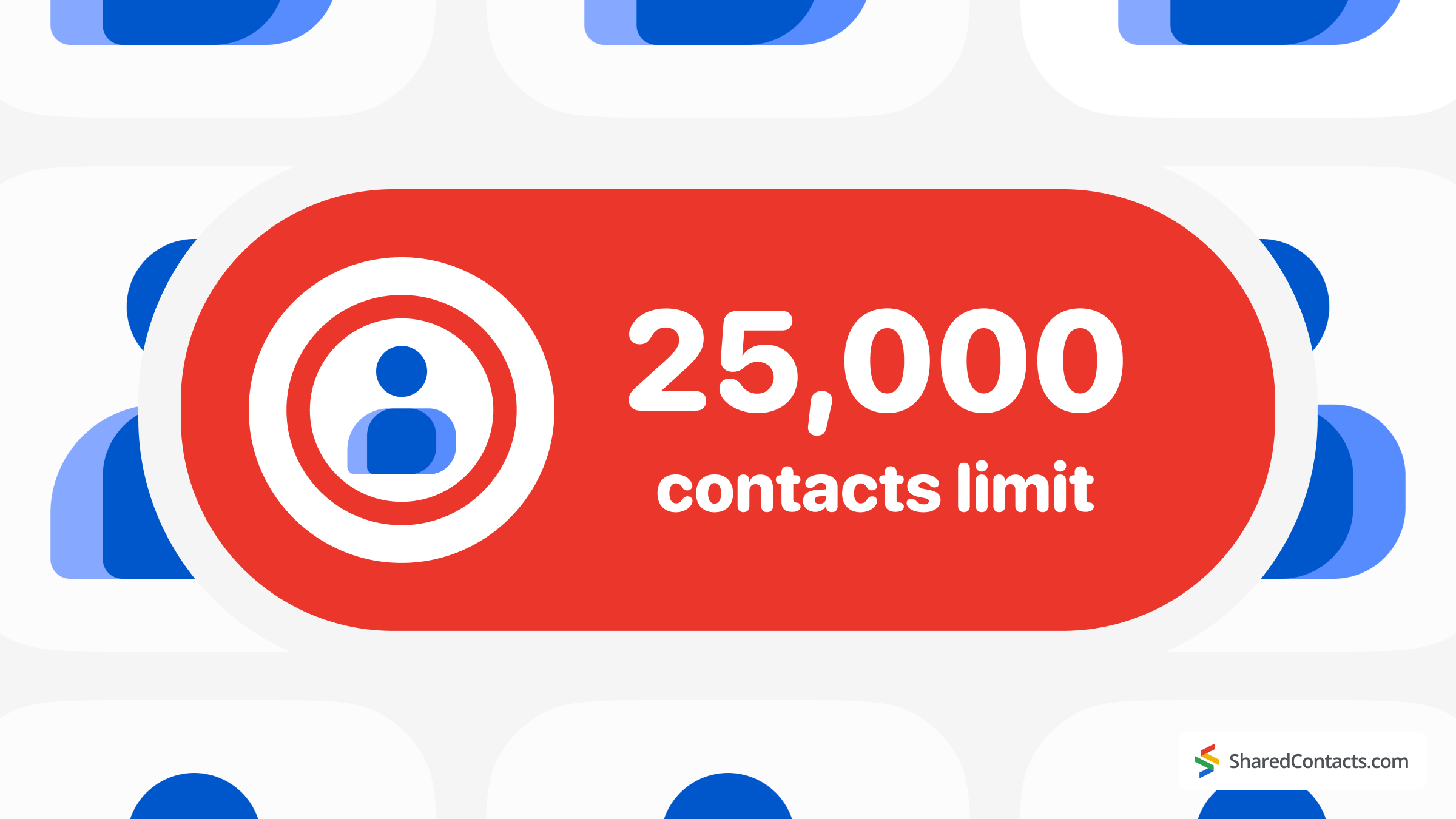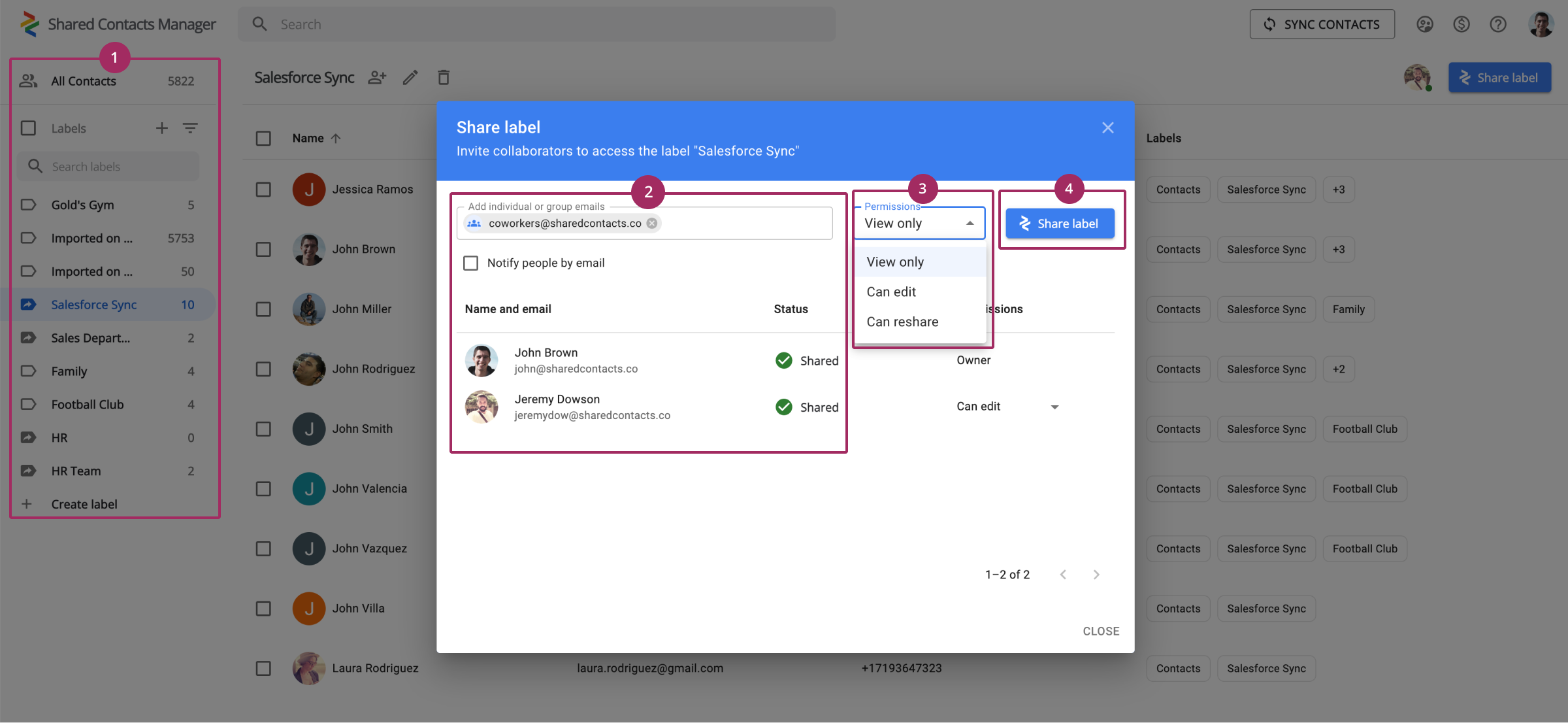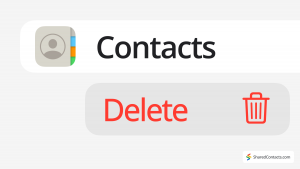Google 연락처 제한에 대한 이해

연락처는 사용자가 클라우드에 연락처를 저장하고 관리할 수 있는 무료 연락처 관리 도구입니다. 그러나 효율적인 서비스를 제공하고 오용을 방지하기 위해 Google은 사용자가 수행할 수 있는 연락처 수, 저장 및 상호 작용에 대해 다양한 제한을 설정합니다.
다음은 한도에 대한 종합적인 분석과 한도에 도달하면 어떤 일이 발생하는지, 그리고 가장 중요한 것은 이를 방지하고 필요한 만큼의 연락처를 유지하기 위해 할 수 있는 일입니다.
Google 연락처 한도 관리 및 여유 공간 확보에 대해 자세히 알아보려면 Google 연락처 한도 문제 및 해결 방법에 대한 동영상을 참조하세요.
Google이 제한을 설정하는 이유
Google은 최적의 성능을 보장하고 남용을 방지하며 리소스를 공정하게 할당하기 위해 제한을 설정합니다. 연락처, 필드 및 기타 항목의 수를 제한함으로써 특히 자동화된 시스템이나 대량 사용자에 의한 과도한 사용으로 인해 플랫폼이 과부하되지 않도록 보호합니다. 이러한 제한은 모든 사용자의 원활한 운영을 유지하는 동시에 스팸이나 기타 악의적인 활동으로부터 시스템을 보호하는 데 도움이 됩니다. 또한 Google은 리소스 사용량을 제어함으로써 불균형적인 리소스 소비를 방지하여 모든 사용자가 효율적으로 서비스를 이용할 수 있도록 합니다.
Google 연락처 한도 상세 정보
Google은 사용자가 저장할 수 있는 정보의 양에 대해 상당히 관대하지만 특정 상황에서는 여전히 임계값에 도달할 수 있습니다.
| 기능 | 제한 |
| 총 연락처 수 | 25,000 |
| 연락처당 크기 | 128KB(131072자) |
| 연락처별 필드 | 500 |
| 그룹별 연락처 | 1,000 |
| 가져오기 | CSV: 한 번에 3,000개의 연락처 저장 vCard: 한 번에 1,000개의 연락처 |
| 일일 API 요청 수 | 사용자당 100,000 |
연락처 저장 한도
각 연락처에는 최대 500개의 필드(이름, 이메일 주소, 전화번호 등)를 가질 수 있으며, 각 필드의 글자 수는 1024자를 초과해서는 안 됩니다. 이러한 제한에 도달하는 경우는 많지 않지만, 특히 사용자 지정 필드에 많은 세부 정보를 추가하면 이 제한에 도달할 수 있습니다.
일반적으로 Google 주소록에는 최대 25,000개의 연락처를 저장할 수 있으며, 총 용량은 20MB로 제한되어 있는 것으로 알려져 있습니다. 이러한 제한에 도달하면 일반적으로 새 연락처를 추가하려는 시도가 차단되어 오류가 발생합니다. 하지만 광범위한 테스트 결과, 실제로 25,000개 이상의 연락처를 저장하는 것이 가능하다는 사실을 발견했습니다. 시스템이 이 임계값을 넘어서는 안정적인 성능을 보장하지는 않지만, 사용자가 임계값을 초과하는 것을 반드시 막지는 않습니다. 하지만 언젠가는 이 오류가 발생할 수 있습니다:
| 연락처를 가져올 수 없습니다. 연락처 25,000개 또는 저장 용량 20MB의 한도에 도달했습니다. 기존 연락처를 삭제하거나 휴지통을 비운 다음 다시 시도하세요. |
연락처별 필드
각 연락처에는 최대 500개의 필드(이름, 이메일 주소, 전화번호 등)가 있을 수 있으며 각 필드의 글자 수는 1024자를 초과할 수 없습니다. 이러한 제한에 도달하는 경우는 많지 않지만, 특히 사용자 지정 필드에 많은 세부 정보를 추가하면 이 제한에 도달할 수 있습니다.
연락처 그룹 제한
하나의 연락처 그룹에는 최대 1,000명의 연락처를 포함할 수 있습니다. Google 그룹의 총 개수에는 지정된 제한이 없지만 총 항목 수 제한인 25,000개 이내로 유지해야 합니다.
연락처 가져오기
CSV 또는 vCard 파일을 통해 연락처를 가져올 때 Google은 한 번에 가져올 수 있는 연락처의 수를 제한합니다. CSV 형식의 경우 한 번에 최대 3,000개의 연락처로 작업할 수 있습니다. vCard 형식을 선호하는 경우 최대 1,000개의 연락처를 사용할 수 있습니다.
API 요청 한도
일반 사용자는 이러한 제한의 영향을 받지 않지만 Google Workspace 관리자와 기타 전문가는 저장 용량 할당량 및 기타 도메인 관련 제한과 같은 문제를 알고 있어야 합니다. Google 주소록 API에는 남용을 방지하기 위한 요청 제한이 있으며, 사용자당 하루에 최대 100,000건의 요청이 가능합니다. API는 속도 제한을 적용하여 짧은 시간 내에 수행할 수 있는 작업(예: 연락처 만들기, 읽기, 업데이트, 삭제)의 수를 제한할 수 있습니다.
Google 주소록 한도에 도달하면 여유 공간을 확보할 때까지 특정 작업이 제한됩니다. 예를 들어, 25,000개 한도를 초과하면 새 연락처를 추가할 수 없다는 오류가 표시됩니다. 마찬가지로 개별 연락처의 데이터가 128KB 크기 제한을 초과하면 Google은 해당 항목에 대한 추가 세부 정보 저장을 중지합니다. 연락처 가져오기 중 연락처 수가 허용된 한도를 초과하면 첫 번째 배치만 처리되고 나머지는 건너뛰게 됩니다. 이 요청 한도에 도달하면 해당 일 동안 추가 작업이 일시적으로 차단되어 기다리거나 사용량을 조정해야 할 수 있습니다. 즉, 이러한 한도에 도달하면 시스템에서 어떤 식으로든 오류를 알려줍니다.
연락처 한도에 도달했을 때 해야 할 일
Google 주소록에서 사용자가 직면할 수 있는 모든 잠재적 제한 사항을 살펴보았지만, 일반적인 사용 환경에서는 대부분 문제가 되지 않습니다. 하지만 25,000개 제한과 같은 일부 제한은 특정 사용자에게 심각한 문제가 될 수 있습니다. 다행히도 이러한 한도에 도달하지 않도록 하거나 시스템에서 최대 용량에 도달했음을 알려주는 경우 여유 공간을 확보할 수 있는 몇 가지 단계가 있습니다. 연락처를 효율적으로 관리하면 오류를 방지하고 앱을 원활하게 계속 사용할 수 있습니다.
불필요한 연락처 삭제
가장 확실한 해결책은 오래되거나 불필요한 연락처를 삭제하여 공간을 확보하는 것입니다. 이 작업은 수동으로 수행하거나 여러 연락처를 선택하여 일괄 삭제를 통해 수행할 수 있습니다.
- 열기 Google 연락처 앱을 클릭하고 연락처 탭으로 이동하여 모든 연락처 목록을 확인합니다. (마찬가지로 다른 연락처 레이블을 선택할 수 있습니다)..
- 삭제할 연락처 선택. 삭제하려는 선택한 연락처 위에 마우스 커서를 올려놓고 이름 옆의 확인란을 선택합니다.
- 를 클릭합니다. 더 많은 작업 버튼 (세로 점 3개) 을 클릭하여 선택한 연락처에 대한 옵션 드롭다운 메뉴를 엽니다.
드롭다운 메뉴에서 삭제 (휴지통 아이콘으로 표시됨) 을 클릭하여 선택한 연락처를 목록에서 제거합니다.

기타 연락처 라벨 관리
다른 연락처를 관리하는 것도 저장 용량을 늘리는 또 다른 방법입니다. Google 주소록에는 Google 앱과 제품을 통해 교류한 사람들을 위한 '기타 연락처'라는 전용 레이블이 있습니다. 이 레이블은 한 번만 필요한 경우에도 다양한 연락처 데이터를 자동으로 저장합니다. 이 라벨에서 연락처는 앞서 설명한 것과 동일한 단계에 따라 제거할 수 있습니다. 또한 설정을 조정하여 연락처가 이 라벨에 자동으로 저장되지 않도록 할 수 있으며, 이렇게 하면 사용자가 수동으로 저장하도록 선택하지 않는 한 상호작용하는 사용자 데이터가 Google에 저장되지 않습니다. 이 기능을 끄는 방법은 다음과 같습니다:
- 회원님의 Google 계정을 클릭하고 왼쪽 탐색 패널에서 사람 및 공유 섹션으로 이동합니다.
- 연락처 패널에서 다음을 찾아 클릭합니다. 상호작용에서 저장된 연락처 정보.
- 설정을 다음과 같이 토글합니다. 꺼짐 를 클릭하여 자동 저장을 비활성화합니다.

Google 연락처 휴지통 폴더 비우기
연락처를 삭제하면 계정에서 즉시 삭제되지 않습니다. 대신 해당 연락처는 휴지통 폴더에 저장되며, 이 폴더는 30일 동안 유지되어 이 기간 동안 저장 공간을 계속 차지합니다.
- 귀하의 Google 연락처를 클릭하고 휴지통 을 클릭하여 이전에 삭제한 연락처 목록을 엽니다.
- 영구 삭제할 연락처를 선택합니다. 모든 연락처를 삭제하도록 선택할 수 있습니다. 휴지통 를 선택하여 모두을 클릭하거나 각각의 상자를 선택하여 개별 연락처를 선택할 수 있습니다.
- 연락처를 선택한 후 영구 삭제 을 클릭하여 영구적으로 제거할 수 있습니다. 또한 지금 휴지통 비우기 버튼을 클릭합니다.
이제 연락처는 복구할 수 없으며 더 이상 저장 공간을 차지하지 않습니다.

중복 연락처 병합
Google 주소록에는 중복된 연락처를 찾아 병합하는 기능이 내장되어 있습니다. 이 기능은 같은 사람에 대한 연락처가 여러 개 있을 때 유용합니다. 계정의 총 연락처 수를 줄이고 공간을 확보하여 연락처를 보다 효율적으로 관리할 수 있습니다.
중복 항목 병합 기능을 설정하고 사용하는 방법은 다음과 같습니다:
- 액세스 Google 연락처 및 클릭 병합 및 수정.
- 중복 제안 검토. 시스템에서 잠재적 중복으로 식별한 연락처 목록이 표시됩니다. 이러한 제안을 검토하여 병합할 수 있는 연락처를 확인할 수 있습니다. 각 제안에는 중복 항목이 나란히 표시되므로 이름, 이메일 주소, 전화번호 등의 정보를 비교한 후 결정할 수 있습니다.
- 연락처 개별 병합. 중복 항목을 개별적으로 병합하려면 제안된 각 중복 쌍 옆에 있는 병합을 클릭합니다. 이 작업을 수행하면 두 항목의 정보가 하나의 연락처로 결합됩니다.
- 모든 중복 항목을 한 번에 병합. Google의 제안을 신뢰하고 모든 중복 항목을 한 번에 병합하려면 페이지 상단의 모두 병합을 클릭하면 됩니다.

중복 항목 병합 기능을 정기적으로 사용하면 연락처 목록을 깔끔하게 정리할 수 있으며, Google 클라우드에 항상 새로운 정보를 저장할 수 있는 공간을 확보할 수 있습니다.
Google 연락처 내보내기 및 백업
Google은 사용자가 백업 목적으로 연락처 목록을 내보낼 수 있도록 허용합니다. 이는 연락처 사본을 Google 시스템 외부에 보관할 수 있는 좋은 방법입니다. 또한 연락처를 내보낸 다음 앱에서 연락처를 삭제하면 공간을 확보하고 Google에서 부과하는 저장 용량 제한을 준수할 수 있습니다. 연락처를 내보내고 백업하는 방법은 다음과 같습니다:
- 다음으로 이동 Google 연락처.
- 내보내려는 연락처를 선택합니다. 를 클릭합니다. 연락처 을 클릭해 저장된 모든 연락처를 확인합니다. 각 이름 옆의 확인란을 클릭하여 내보낼 개별 항목을 선택하거나 모든 연락처를 내보내려면 상단의 확인란을 클릭하여 모든 항목을 선택할 수 있습니다.
- 열기 내보내기 메뉴. 연락처를 선택한 상태에서 추가 옵션 아이콘(세로 점 3개)을 클릭합니다. 선택 내보내기 드롭다운 메뉴에서 클릭합니다.
- 내보내기 형식을 선택합니다. Google 주소록은 연락처 내보내기를 위한 두 가지 주요 형식을 제공합니다:
- Google CSV: 다른 Gmail 계정이나 Google 스프레드시트로 옮기는 데 가장 적합합니다. 여기에는 Google 주소록에서 사용하는 모든 데이터 필드가 포함되어 있습니다.
- Outlook CSV: 이 형식은 Microsoft Outlook 또는 이 유형의 파일을 허용하는 다른 서비스에서 연락처를 사용하려는 경우 선택할 수 있습니다.
- vCard (iOS 연락처의 경우): Apple 제품에서 사용하는 일반적인 형식입니다. 다른 많은 서비스 및 장치에서 지원하는 범용 형식이기도 합니다.
5. 클릭 내보내기. 파일이 장치에 다운로드됩니다.

내보낸 연락처 파일을 다운로드한 후 안전한 위치에 보관하세요. Google 드라이브와 같은 클라우드 저장소나 외장 하드 드라이브 또는 USB 디스크에 백업하여 안전하게 보관하는 것이 좋습니다.
Shared Contacts Manager로 한계를 뛰어넘으세요

Google 주소록 제한이 제한적으로 보일 수 있지만, 이러한 제약을 관리하고 우회할 수 있는 더 스마트한 방법이 있습니다. 사용 Shared Contacts Manager를 사용하면 모든 연락처를 하나의 계정에 몰아넣을 필요가 없습니다. 대신 여러 계정과 도메인에 연락처를 분산할 수 있습니다. Google 연락처 공유 를 사용하면 회사 내 모든 사람이 문제 없이 액세스할 수 있습니다. 따라서 단일 계정의 저장 용량 한도를 초과하지 않고도 표준 한도가 허용하는 것보다 훨씬 더 많은 연락처를 팀에서 공동으로 관리할 수 있습니다.
또한 Shared Contacts Manager는 연락처를 간편하게 정리하고, 공유하고, 실시간으로 액세스할 수 있습니다. 할당하는 권한에 따라 팀원들은 항상 필요한 데이터를 확보할 수 있습니다. 이 도구를 사용하면 연락처를 액세스하고, 체계적으로 관리하고, 통제할 수 있습니다. Google의 한계를 극복할 준비가 되셨나요? Shared Contacts Manager를 14일 동안 무료로 사용해보고 연락처 관리 기능을 강화하여 유연한 협업 방식을 즐겨보세요.


1 댓글
Saya hanya bisa menyimpan 100 연락처. 연락처가 100개 이상일 때만 가입할 수 있습니다. 더 많은 연락처를 만들려면 어떻게 해야 하나요?